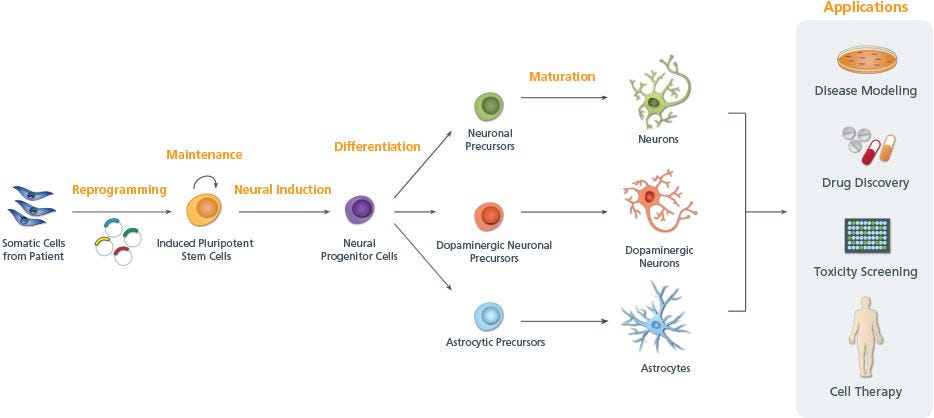Modeling Human Neurological Disease with Induced Pluripotent Stem Cells
Traditionally, rodents have been popular model organisms for neurological disease research, owing to the difficulty of obtaining human brain tissue for experimental studies. However, because of differences in brain development and signaling pathways, these animal models may not be fully representative of human disease pathology. In recent years, driven by technological advances, researchers have begun using induced pluripotent stem (iPS) cells to generate more representative models for studying human neurological disease. These iPS cell-based models hold tremendous potential for the study of human neurological disease. Researchers can now generate patient-specific differentiated cell types, bridging the gap between studies using animal models, and clinical research.

Figure 1. Neurological Disease Modeling Workflow and Applications
Applications of iPS Cell-Based Models
- DISEASE MODELING. Generate patient-specific human "disease-in-a-dish" models.
- DRUG DISCOVERY. Screen drug candidates on physiologically relevant human cell types, including diseased cells.
- TOXICITY SCREENING. Evaluate neurotoxicity on differentiated human neural cell types.
- CELL THERAPY VALIDATION. Generate human neural cell types for pre-clinical validation of potential cell therapy applications.
Advantages Over Traditional Animal Models Include:
- IMPROVED DISEASE MODELING. Animal models are often not fully representative of disease pathophysiology, owing to differences in brain development and signaling pathways.
- INCREASED PHYSIOLOGICAL RELEVANCE. Use of human cells brings research closer to the clinic.
- EXPANDED MODELING OPPORTUNITIES. Generation of patient-specific iPS cell lines enables researchers to model complex diseases for which there are no suitable animal models eg. autism.
- REDUCED MOUSE HUSBANDRY. No need to breed and maintain transgenic mouse colonies.
Tools for hPSC-Based Neurological Modeling
From neural induction to neuronal functional characterization, optimized tools and reagents are available for every step of your hPSC-neural workflow. Use the STEMdiff™ Neural System and/or BrainPhys™ Neuronal Medium to generate functional neural cell types for versatile downstream applications.
A Complete System for Your Neurological Disease Modeling Research
Use the STEMdiff™ Neural System to generate, expand, differentiate, characterize and cryopreserve your ES/iPS cell-derived neural progenitor cells. From induction to maturation, the STEMdiff™ Neural System completes your ES/iPS cell-neural cell workflow, enabling you to generate your cell-types-of-interest to meet your research needs.
BrainPhys™ Neuronal Medium: A New Way to Culture Neurons
For a physiologically relevant disease model, use BrainPhys™ Neuronal Medium, a new culture medium designed to better support in vitro neuronal function. In BrainPhys™ Neuronal Medium, neurons experience brain-like neurophysiological conditions and develop a higher proportion of synaptically active neurons. After differentiation, mature your cells in BrainPhys™ Neuronal Medium for a healthy, synaptically active culture.
